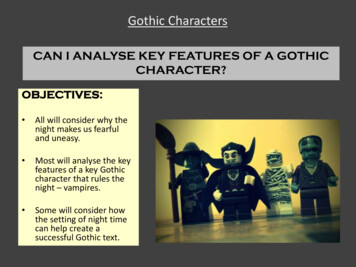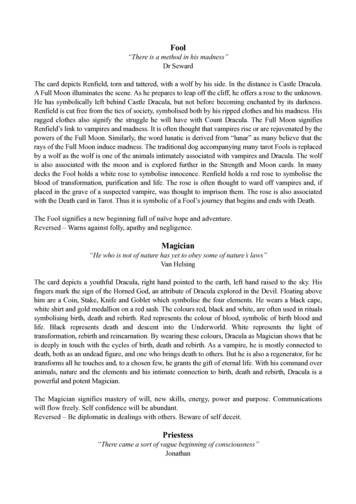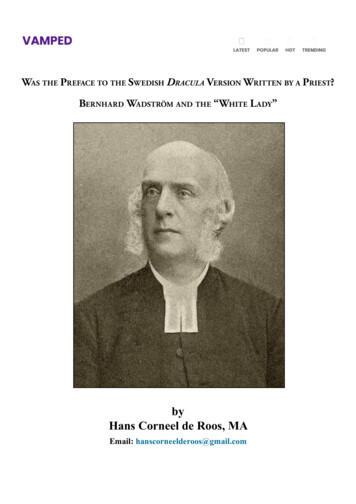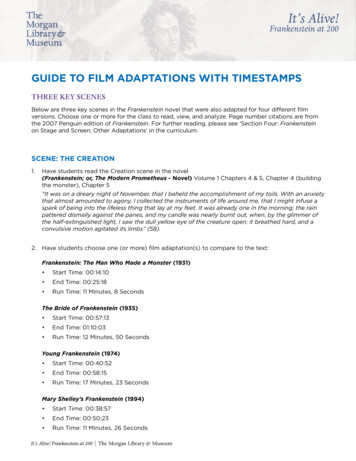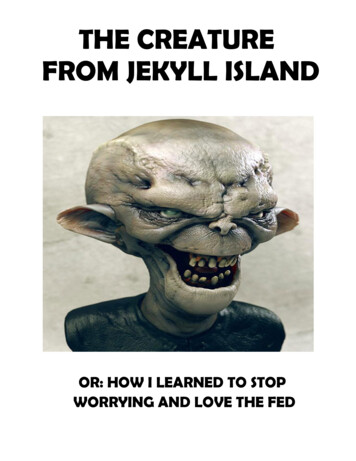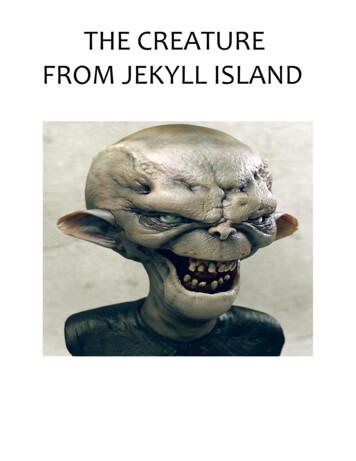
Transcription
Draculaby Bram StokerAll new material 2009 Enotes.com Inc. or its Licensors. All Rights Reserved.No portion may be reproduced without permission in writing from the publisher.For complete copyright information please see the online version of this text athttp://www.enotes.com/dracula
Table of ContentsIntroduction.1Bram Stoker Biography.2Summary.3Chapters 1-4 Summary.3Chapters 5-16 Summary.3Chapters 17-24 Summary.4Chapters 25-27 Summary.4Themes.6Style.8Historical Context.9Critical Overview.10Character Analysis.12Count Dracula.12Other Characters.12Essays and Criticism.16Stroker's use of Time in Dracula.16Stoker, Bram.18Dracula: Novel by Bram Stoker, 1897.20Dracula: The Unseen Face in the Mirror.21Dracula: Bram Stoker's Spoiled Masterpiece.27Compare and Contrast.34Topics for Further Study.35Media Adaptations.36Bibliography and Further Reading.37i
IntroductionDracula, by Abraham Stoker—who generally published under the abbreviated first name Bram—was firstpublished in Great Britain in 1897. Although myths and legends about vampires had existed since ancienttimes, Stoker's novel synthesized much of this lore and gave it a palpable feeling in the character of CountDracula. In fact, the character of Dracula has since become so popular that many people who were firstexposed to the famous vampire through film or television do not even know who Stoker is. While films, mostnotably the 1931 film Dracula, starring Bela Lugosi, have overshadowed the book, they have also helped tokeep the story alive. In the last half of the twentieth century, the onslaught of Dracula films has added evenmore mystery to the legend of Count Dracula.Stoker's inspirations for Count Dracula are heavily debated. However, most critics agree that Dracula wasbased in part on a historical figure, Vlad the Impaler, a fifteenth-century Romanian ruler known for hisindiscriminate brutality, which included a taste for impaling people alive on wooden spikes and watchingthem die in slow agony. Other inspirations suggested by scholars include John Polidori's story "The Vampyre"(1819), Sheridan Le Fanu's novella Carmilla (1872), and Emily Gerard's Transylvanian travel book The Landbeyond the Forest: Facts, Figures, and Fancies from Transylvania, which was published in the late 1880s,right before Stoker wrote his novel. However, while these and other sources have been named as potentialinspirations, most modern critics agree that Stoker put his own spin on the vampire myth. In fact, Stokerworked longer and harder on this novel than any of his other works, taking seven years to research and writeDracula.While the character of Count Dracula was important for establishing the conventions of what would becomean entire genre of horror tales, the book's plot was also very timely. In their exposure to Dracula and theirattempts to catch him and destroy him, the various vampire hunters underscore the Victorian attitudes thatwere present at this time. The Victorian Age took place in England during the reign of Queen Victoria(1837-1901). Victorian moral and religious beliefs included the expected roles of men and women. This ismost notable in the book's discussion of sexual matters, which are portrayed in both literal and symbolic ways.The student who wishes to dig deep into the historical and cultural context of the novel should check out TheAnnotated Dracula (1975), by Leonard Wolf. This edition, which is currently out of print, is available inmany libraries. The edition includes extensive footnotes to the text, as well as maps, photographs, andcaptivating illustrations that underscore the Gothic aspects of the novel.Introduction1
Bram Stoker BiographyBram Stoker was born Abraham Stoker on November 8, 1847, in Clontarf, north of Dublin, Ireland. Stokerwas the third of seven children, and he was violently ill as a child. When he was sick, Stoker read many booksand listened to the horror tales his mother told him. These led Stoker to start writing ghost stories, even as achild. After graduating from Trinity College, Dublin in 1868 with honors in mathematics, Stoker took a civilservice position, but he most enjoyed going to the theater in his free time. In 1871, when local critics did notcomment on a performance of Henry Irving— Stoker's favorite actor—Stoker offered to write an unpaid reviewof the performance for the Dublin Mail. Stoker continued to write unpaid reviews for the newspaper forseveral years. When Irving returned to Dublin to perform in 1876, Irving read Stoker's celebratory review ofthe actor's performance and invited Stoker to dinner. The two men struck up a friendship, and, in 1878, Irvingleased the Lyceum Theatre in London and appointed Stoker as manager. Stoker married his neighbor,Florence Balcombe, and the two moved to England where Stoker worked both as the theater manager and asIrving's acting manager from 1878 to 1905.Bram StokerAt the same time, Stoker began to publish his own works. In 1882, Stoker published his first book, Under theSunset, a book of twisted children's stories. Eight years later, he published his first novel, The Snake's Pass(1890). However, it was not until the 1897 publication of Dracula that Stoker received real attention from thecritics, and even then it was mixed. However, although the critics were hesitant to endorse Stoker's horrornovel, it was a popular success. Despite Stoker's good fortune, he remained loyal to Irving, whose badbusiness practices and failing career eventually led the two men to abandon the Lyceum Theatre. FollowingIrving's death in 1905, Stoker—who had always been in the actor's shadow—was distraught. Stoker had a strokeshortly after Irving's death, which incapacitated him somewhat. At the end of his life, Stoker and his wifebecame increasingly poor, and he looked to others for assistance. At the same time, he continued to write. Hisworks in this late stage include Lady Athlyne (1908), The Lady of the Shroud (1909), and The Lair of theWhite Worm (1911). Stoker died of syphilis on April 20, 1912, in London. However, Stoker'sDracula haslived on and has since overshadowed its author.Bram Stoker Biography2
SummaryChapters 1-4 SummaryDracula starts out with several entries in Jonathan Harker's journal, which comprise the first four chapters.These entries set the structure for the rest of the novel, which is also told mainly through journal entries andletters. This first section introduces Harker, who is a recently promoted English solicitor (a type of attorney).Harker travels eastward across Europe from London to Transylvania, where he is going to meet CountDracula and explain to the count the particulars of his London real estate purchase. As he travels across thecountry to the castle, he notices the reaction of various area residents who are frightened by Dracula's name.At Harker's last checkpoint, a coach from Dracula's castle arrives for him. Harker notes the strength of thedriver. When he arrives at Dracula's castle, the count, an older gentleman, opens the door, and Harker notesthat Dracula is also very strong. Over the next several days, Harker notes that Dracula is never around duringthe daytime, there are no mirrors in the castle, Dracula has no reflection in Harker's shaving mirror, andDracula appears to be alone in the castle. Harker realizes that he is a prisoner.At Dracula's request, Harker writes to his supervisor and to his fiancée, Mina Murray, letting them know thecount wishes him to stay for a month. Dracula warns Harker that it is unsafe to wander the castle, andespecially to fall asleep in any part of the castle other than his room. Harker ignores Dracula's advice and goesexploring. On two occasions, he sees Dracula scaling the castle wall at night, like a lizard. Harker is almostbitten by three women but is saved by Dracula, who warns them to keep their hands off Harker, saying thatthe solicitor belongs to him. Dracula gives them a baby to eat instead. Harker watches several days later as thebaby's mother stands outside the castle, demanding that Dracula give her back her child. Dracula says a fewcommands, and a pack of wolves comes and eats the woman. Desperate, Harker climbs down the wall of thecastle and discovers Dracula in his coffin. Harker realizes that the count has no heartbeat and appears to bedead. In the evening, Dracula reappears, and Harker demands that the count let him go. However, whenDracula obliges and opens the door, a pack of wolves appears. Harker, disheartened, realizes that Dracula isnot really going to let him go. Harker overhears Dracula telling the three women that they can have Harker thenext night. In the morning, Harker tries to escape but finds every way locked. Ultimately, he decides to climbdown the castle wall and try to reach a train back to England.Chapters 5-16 SummaryLucy and Mina write back and forth to each other several times, discussing Lucy's engagement to ArthurHolmwood and her denial of two other suitors, Dr. John Seward and Quincey Morris. Se-ward works with hispatient, Renfield, who has a penchant for trying to eat bugs in an attempt to suck the life out of them. Minagoes to Whitby with Lucy and her mother to vacation while waiting for Jonathan. She sees a mysterious shiparrive, which lost most of its crew at sea. The ship is carrying fifty boxes. Lucy begins sleepwalking and startshaving nightmares. Dracula bites her, but Mina mistakes the holes on Lucy's neck for something else. Lucystarts to get weak and pale, and Mina assumes she is getting sick. Renfield is restless over the presence of hismaster. Mina receives word that Jonathan is in a hospital in Budapest, and she travels there to join him. Theyare married. Mina also writes several letters to Lucy, telling her about Jonathan's journal from Castle Dracula,which she has promised not to read since she does not wish to know the cause of her husband's madness.Meanwhile, in Whitby, Lucy gets weaker. Holmwood asks Dr. Seward to look at Lucy. Seward does, but inturn sends for his old mentor, Professor Van Helsing, who is alarmed at Lucy's anemic state. He performs ablood transfusion, transferring some of Holmwood's blood into Lucy. Although this temporarily helps Lucy,she keeps getting worse and gets transfusions from three other men: Seward, Morris, and Van Helsing. VanHelsing also insists on making Lucy wear garlic around her neck, but her ill mother removes it. A wolf breaksSummary3
through the bedroom window that night, giving Lucy's weak mother a fatal heart attack. Lucy dies two dayslater. Jonathan and Mina return home, and Jonathan sees Count Dracula on a street. Jonathan and Mina hearof Lucy's death from Van Helsing. They also hear of an attractive lady who has been snatching children fromnear the cemetery. Van Helsing speaks with Mina, who lets him read Jonathan's journal. He assures Jonathanthat his experiences at Castle Dracula actually happened. Van Helsing hears about the woman in the cemeteryand realizes that this is Lucy, now a vampire. He takes Seward to the cemetery at night and shows him Lucy'sempty tomb. The next night, Seward, Van Helsing, Morris, and Holmwood return to the cemetery, where theyencounter the vampire Lucy. She tries to attack but is driven back by Van Helsing's cross. The following day,the four men enter Lucy's tomb, and Holmwood drives a stake through her heart.Chapters 17-24 SummarySeward reads Jonathan's diary, while Mina listens to Seward's account of how they killed the vampire Lucy.Mina collects all of the notes she can on Dracula from Seward's diary, Jonathan's diary, and various othersources. She and Jonathan weave it into a chronological account of the past couple of months, which theypresent to Van Helsing and the rest of the group. Mina visits Renfield, then the group assembles to discussDracula. Van Helsing gives them all some historical background on vampires, and they ultimately decide tojoin forces to try to find Dracula's various resting places, the boxes of earth that came over on the ship, andconsecrate them so that he cannot use them. Renfield, afraid of losing his soul, makes a desperate plea to Dr.Seward to be set free. Harker leads the men to Dracula's house, Carfax, which is right next door to the asylum.They discover a little more than half of the boxes of earth. Dracula, who can only gain access to a home if heis invited, gets Renfield to let him in. He starts sucking blood from Mina every night, although she mistakeshis visits for nightmares. Mina starts to get noticeably weaker and paler.While the men hunt down the rest of Dracula's coffins, Mina rests more and more. One night, Seward is calledto attend to Renfield, who has been fatally injured in an inexplicable way. By talking to him, Seward and theother men, minus Harker, find out that Dracula visited Renfield, who realized that the count had been suckingblood from Mina. Renfield tries to prevent the count from attacking Mina anymore, but Dracula overpowershim, throwing him to the floor. The men rush upstairs to Mina's room, where they see Dracula forcing her tosuck his blood, while Jonathan is in a stupor. Van Helsing drives Dracula away with a eucharist wafer, butlater, when he presses a wafer on Mina's forehead as a protection, it burns her. Everybody realizes that Minais half-transformed into a vampire. The men return to Carfax to consecrate the boxes of earth. They findDracula's other houses and split up to consecrate the other boxes. However, they only find forty-nine out ofthe fifty boxes and realize that Dracula still has one left. They assemble at one of Dracula's houses, waiting forthe count to arrive. When he does, he tries to attack them, but Jonathan counters with his knife. Likewise, theother men help to drive the count off with their crucifixes.As Mina's condition worsens, they realize that she has a psychic link to Dracula. As a result, Van Helsingstarts hypnotizing her during sunrise and sunset when this link is activated, and through Mina they realize thatDracula is going to try to escape back to his castle by ship. The men plan to chase Dracula and, after somediscussion, Mina goes along, too.Chapters 25-27 SummaryThe group splits up to chase Dracula in three ways. While Van Helsing and Mina travel to Castle Dracula,Seward and Morris chase the count over land, and Harker and Holmwood hire a river steamer. Although thethree unnamed vampire women from Dracula's castle try to coax Mina away from Van Helsing, he thwartsthem with holy items, then travels to the castle in the daytime to kill the three female vampires. Meanwhile,the two groups of men quickly catch up with Dracula, who is being transported by a group of gypsies. WhenDracula is close to his castle, the group of vampire hunters arrives on the scene at the same time. In theChapters 5-16 Summary4
ensuing fight, the gypsies are driven off, but not before they give Quincey Morris a fatal wound. Still, he andJonathan are able to kill Dracula, just moments before Dracula is about to transform himself into an etherealshape. As Jonathan's knife decapitates the count and Quincey's knife stabs him, the vampire turns into dust.Mina notes in an epilogue that she and Jonathan have named their son Quincey and that their story wouldseem very farfetched to others.Chapters 25-27 Summary5
ThemesSalvation and DamnationAs several characters note in the novel, a person's physical life is of secondary importance to the person'seternal life, which can be jeopardized if the person is made evil by a vampire like Dracula. Professor VanHelsing says, when he is explaining why they must kill the vampire Lucy, "But of the most blessed of all,when this now Un-Dead be made to rest as true dead, then the soul of the poor lady whom we love shall againbe free." Even characters that are of questionable goodness, such as the mental patient, R. M. Renfield, realizethat, although they can find immortality by being a vampire, they cannot find salvation. Renfield says, whenhe is begging Dr. Seward to let him go, not explaining that he is afraid of his master, Dracula: "Don't youknow that I am sane and earnest now; that I am no lunatic in a mad fit, but a sane man fighting for his soul?"When Mina is distraught after realizing that Dracula has started to turn her into a vampire, Van Helsing warnsher to stay alive if she wants to achieve her salvation. "Until the other, who has fouled your sweet life, is truedead you must not die; for if he is still with the quick Un-dead, your death would make you even as he is."Roles of Men and WomenThe novel underscores the expected roles of men and women in Victorian times. Women were expected to begentle and ladylike and, most of all, subservient to men. For example, in one of her letters, Lucy notes, "Mydear Mina, why are men so noble when we women are so little worthy of them?" Lucy is frustrated that shehas to choose between her three suitors and does not wish to hurt any one of them by saying no. Lucy says,"Why can't they let a girl marry three men, or as many as want her, and save all this trouble? But this isheresy, and I must not say it." Women are expected to live for their husbands, so much so that Mina practicesher shorthand while Jonathan is away so that she can assist him when he gets back. Mina says, "When we aremarried I shall be able to be useful to Jonathan."Even more important than a woman's devotion to her husband was the idea that women, at least gentlewomen,should be pure. As part of this, men were expected to respect a woman's privacy and never burst in on herwhen they might catch her in an undressed state. Quincey notes this when Professor Van Helsing says theyneed to break down the door to Mina's room. Quincey states, "It is unusual to break into a lady's room!"However, as Van Helsing notes, in situations where the woman might be in mortal danger, this rule should bebroken. Van Helsing is worried, rightly so, that Dracula might be attacking Mina. So he replies to Quincey,"You are always right; but this is life and death."In fact, the role of men as saviors of their women, which is underscored again and again in the novel, wasanother aspect of Victorian life. When it came to danger, especially physical danger, women were expected toact like damsels in distress. Mina fulfills this role after she is bitten and looks to Jonathan for support. NotesMina of Jonathan's hand, "it was life to me to feel its touch—so strong, so self-reliant, so resolute."Reason and MadnessThe novel also explores the ideas of reason and madness. In the beginning, Jonathan believes that he is goingmad when he sees the three women vampires appear out of thin air. Later, he thinks that all of his experienceswere the result of hallucinations brought on by madness. Seward works at an insane asylum, so he is exposedto madness every day. As a result, Seward tends to always follow his scientific reasoning, a fact that VanHelsing notes, "You are a clever man, friend John; you reason well, and your wit is bold; but you are tooprejudiced. You do not let your eyes see nor your ears hear." Because of this, Seward does not believe in thevampire Lucy, even after seeing her the first time. His mind is unable to reconcile the supernatural things thathe has seen, and so it simply blocks them out, at least temporarily. He is the type of man who would ratherbase his life on hard facts and hard science and who likes to use the newest technologies like the phonograph.His mentor, Van Helsing, is also an accomplished scientist, but he realizes that sometimes it is necessary toforget what one has been taught and believe in something else, even if it seems mad or heretical. Van HelsingThemes6
says "it is the fault of our science that it wants to explain all; and if it explain not, then it says there is nothingto explain."Themes7
StyleGothic NovelDracula is a Gothic novel, which is also sometimes known as a Gothic romance. Many scholars considerHorace Walpole's novel The Castle of Otranto (1764) to be the first Gothic novel. Like Dracula, Walpole'snovel was wildly popular. Gothic novels generally focus on mystery and horror, and they usually have somesupernatural elements. InDracula, the supernatural elements are many, starting with the use of a vampire asthe title character. In addition, the specific attributes given to the vampire underscore his inhumanity. Jonathansays, after witnessing Dracula scale the castle wall like a lizard, "What manner of man is this, or what mannerof creature is it in the semblance of man?" Jonathan's plight in the beginning, when he is trapped in Dracula'scastle, is also typical of Gothic novels, which often place their heroes in seemingly inescapable situations.Finally, the various settings—including Dracula's imposing castle, the ghostly landscape of Transylvania, andthe graveyard and Lucy's tomb in London—are all settings that are found in Gothic fiction.Epistolary NovelIn addition to being a Gothic novel, Dracula is also an epistolary novel, meaning that it is told through aseries of letters instead of a single, connected narrative. Actually, although letters like these compose some ofthe plot, particularly the exchanges between Mina Murray and Lucy Westenra, the book also relies on journalentries and news articles to tell the tale. In fact, the book begins with an entry in Jonathan Harker's journal:"Left Munich at 8:35 p.m. on 1st May, arriving at Vienna early next morning." Some of these entries, like theone referenced above, contain mundane details about Harker's journey. These specific details about Harker'sjourney give the book a feel of realism, which is consistent with the naturalistic movement that becamepopular at the turn of the nineteenth century. It also helps to counterbalance the supernatural aspects of thenovel by making it seem as if the book is true.In epistolary novels like this one, the narration is all in the first person. However, in Dracula, which bouncesaround from character to character, readers receive several first-person accounts. This disjointed approachhelps to disorient the reader, who must try to figure out what is going on based on several separate accounts.SuspenseThe use of multiple first-person narrators helps to increase the suspense in the book, since Stoker jumpsaround from character to character, building tension in a certain situation and then moving on to the next one.In this way, the reader is left to wonder what is going to happen in a specific situation or to a specificcharacter. The best example of this is the anticipated fate of Jonathan Harker. In the first four chapters, Stokerbuilds suspense, starting on Harker's journey. After hearing enough warnings from the local residents, Harkerstarts to be concerned for his safety and notes, "I am not feeling nearly as easy in my mind as usual. If thisbook should ever reach Mina before I do, let it bring my goodbye." Although Jonathan later thinks he wasoverreacting, at least when he first meets the count, the seed of doubt and suspense is planted in the reader'smind. This seed continues to grow as Jonathan notices certain things about Dracula: "The mouth, so far as Icould see it under the heavy moustache, was fixed and rather cruel-looking, with peculiarly sharp white teeth."As he stays at the castle, Jonathan gives readers even more information about Dracula's vampiric qualities,which help to heighten the suspense.However, at the end of the fourth chapter, Stoker adds the most suspense of all, when he has Jonathanannounce his intention to try to leave the castle, "I shall try to scale the castle wall farther than I have yetattempted. And then away for home! away to the quickest and nearest train!" While readers root forJonathan, they must wait several chapters to find out whether or not he is successful in his attempt, since thenovel switches gears and starts to talk about the experiences of Mina and Lucy. The novel continues to buildsuspense, which culminates in the massive chase to kill Dracula and save Mina.Style8
Historical ContextOrganized Religion in the Victorian AgeThe Victorian Age witnessed both a rising and falling in the popularity of organized religion. When religiousactivity was at its peak, it was pervasive. Morality and religion—especially the Christian religion—infused allaspects of life. Stoker's use of Christian elements such as a cross and a eucharist wafer as weapons against theevil Dracula underscores this idea. However, by the end of the century, when Stoker wrote Dracula, the moralcompass was not as clear, and many people experienced a crisis in their religious faith. This was due in largepart to the publication of several scientific works that challenged conventional notions of religion. One of themost famous of these was Charles Darwin's Origin of Species (1859).Sexuality in the Victorian AgeIn many ways, the Victorian Age was paradoxical. On the outside, men and women strove to appear pure andconservative. They observed proper courtship rituals, adopted an uninterested attitude towards sex, and at alltimes tried to act with decorum—at least in public. In private, however, it was a different story. The same timeperiod that saw all of these restrictive rules also witnessed a booming prostitution industry. While this wasgenerally accepted, there was one form of sex that was considered deviant and criminal: homosexuality.Through part of the Victorian Age, homosexuality was a capital offense. However, by the 1890s, the sentencehad been reduced to prison time, which was the fate of noted author Oscar Wilde.During the Victorian Age, pornography found a huge audience. In 1890, an anonymous author published MySecret Life, a massive autobiography that detailed the author's sexual experiences and gave an accurateportrayal of the darker side of Victorian society. While some people wrote about sex in an academic sense,studying the sociological and psychological aspects of human sexuality, some people found it hard to make adistinction between these scholarly studies and pornography that was meant only to arouse. One of people'sfears about pornography was that it might lead to sexually criminal behavior, such as rape.Jack the RipperIn the late 1880s, when Stoker was getting ready to write his novel, London's East End was terrorized by ananonymous serial murderer known simply as Jack the Ripper. Although these crimes did not include sexuallydeviant acts like rape, most of the Ripper's victims were prostitutes, which has led some to believe that themurderer's motivation may have been sexual in nature, perhaps a consequence of sexual repression.Health and Medicine in the Victorian AgeVictorians were extremely worried about their health, especially in London, where crowded and unsanitarycity conditions often led to widespread disease. Medicine in the nineteenth century was largely undeveloped,and medical education wa
an entire genre of horror tales, the book's plot was also very timely. In their exposure to Dracula and their attempts to catch him and destroy him, the various vampire hunters underscore the Victorian attitudes that were present at this time. The Victorian Age took place i
